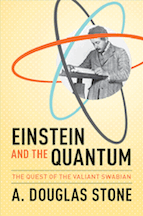Anna Moyer
While popular sentiment associates the name Albert Einstein with phenomenal genius, the equation E=mc2, and a perhaps nebulous understanding of his general theory of relativity, in Einstein and the Quantum: the Quest of the Valiant Swabian, A. Douglas Stone elegantly presents Einstein’s intimate involvement in the development of a field for which he is less well known: quantum mechanics. From his days spent appraising patent applications in Bern to receiving the Nobel Prize, Einstein’s lifelong inquiry into the atomic world is outlined by Stone through a compelling amalgam of biography and the cultural history of physics. Yet, despite Einstein’s decisive contributions to major concepts of the field, Stone closes the account of Einstein’s efforts in quantum mechanics with a discussion of the physicist’s philosophical struggle to accept a conceptual structure that frustrates the ability of science to observe the world objectively.
Chapter by chapter, Stone traces the string of developments in physics that generated questions about the nature of light and atoms. He focuses both on the tension between experimental data and their theoretical explanations, and on the interactions between physicists. By quoting letters, lectures, and physics publications, Stone immerses readers in the bustling cultural and scientific life of the early twentieth century.
The tale begins in 1900 when Max Planck develops the correct formula to account for empirical data describing the relationship between heat and light, but fails to connect his law to more fundamental laws of physics. The formulation of Planck’s law represents a decisive moment in the field of physics by serving as a portent of the breakdown of the concept that Newtonian mechanics alone can describe physical phenomena. Together with contributions from physicists such as Millikan, Bohr, Bose, Schrödinger, de Broglie, Born, Heisenberg, and Pauli, Einstein’s interpretation of Planck’s law and related studies ultimately resulted in the formation of modern quantum mechanics. Despite his relatively undervalued role in quantum mechanics, Einstein advanced most of the crucial concepts in the field, including quantization of energy, wave-particle duality, and the indistinguishability of quantum particles.
To non-specialists, scientists present findings as undeniable by shrouding the details of the processes used to come to conclusions – what is it, exactly, that a theoretical physicist actually does? Stone deconstructs the processes of experimental and theoretical physics by chronicling both successes and failures, epiphanies and discouragements, and social dissonance and accord. By revealing the methods behind the development of quantum mechanics, Stone makes the process of the science believable even to scholars outside of the field of physics.
At the start of the Einstein and the Quantum, he posits that “the theorist’s job was (and is) simply to predict and understand physical systems … Experimentalists are playing poker; theorists are playing chess.” Throughout the following chapters, Stone recounts the decades long chess match for quantum theory move by move, with commentary that is both academic and comprehensible. The depth of social history of these physicists is equally irresistible; readers will learn how Einstein rose to public acclaim from his post at the patent office, how personal feuds between physicists influenced the forward progress of the field, and how scores of scientists communicated complex ideas across countries even throughout the Great War.
Another strength of the account is Stone’s use of palpable analogies to explain potentially challenging physics concepts. For instance, he compares the propagation of waves through a medium to a crowd of spectators doing the wave, directed atomic emission to a platoon of soldiers on a raft firing guns, and the Doppler effect to a swimmer walking to one end of a wave pool. However, Stone does not shy away from delving into more nuanced features of quantum mechanics, and motivated readers who are not well-versed in the field may wish to refer to additional resources, in conjunction with the two included appendices, to fully grasp the content examined.
Einstein and the Quantum is not just a biography of Einstein’s life, not just an account of the scientific development of quantum mechanics, and not just a cultural history of early twentieth century physicists. The fusion of information from these spheres creates a coherent and enjoyable picture of Einstein’s contributions to our understanding of the interactions between energy and matter and gives perspective to the breadth of his scientific achievement. Stone’s integrated evaluation elucidates Einstein’s devotion to uncovering the details of quantum mechanics and culminates in his ultimate rejection of a theory that blurs the line between objective reality and subjective human perception at the hands of a dice-playing God.
Anna Moyer (ΦBK, University of Alabama, 2014) is in her last year of a dual Bachelor’s/Master’s program at the University of Alabama where she is majoring in biology and minoring in English. The University of Alabama is home to the Alpha of Alabama Chapter of Phi Beta Kappa.




